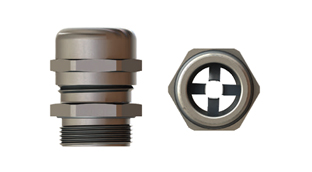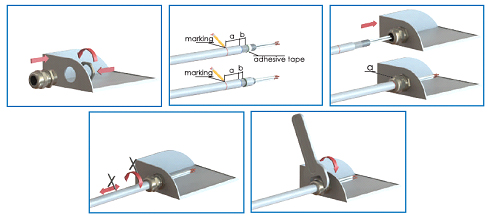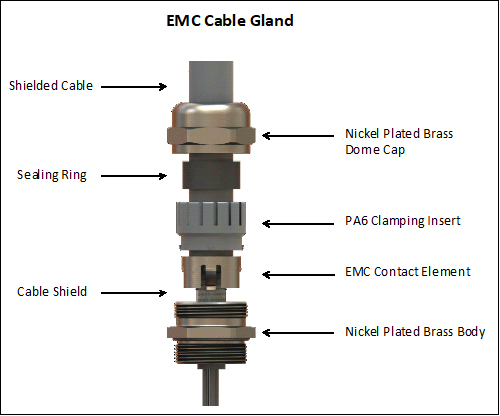EMC cable glands are special type of cable glands used in order to avoid electromagnetic interference. These glands include a special EMC component that enlarges the contact with the cable shield. They are used for electrical, control, instrumentation, data, and telecommunication applications allowing the user to maintain full integrity of the signals being transmitted by the shielded cable by just tightening the gland.

EMC cable glands are a High performance cable gland which offers Ingress protection rating of up to IP 68 with high quality strain relief and easy assembly with excellent shielding with a long lasting shielding contact.
These cable glands combine several advantages in one product. First, you get the same clamping ranges as the standard brass glands. The Ingress Protection Rating is IP68.
In order to get a low electrical impedance between the cable gland and the braiding of the cable the cable gland does not have to be disassembled. Secondly, a perfect shielding will be achieved by just tightening the dome nut. This high tech cable gland consists of a nickel plated brass body, PA6 clamping insert, an EMC contact element and chloroprene seal. The components are pre-assembled inside the body of the cable gland.
These special application EMC cable glands are manufactured using nickel-plated brass or stainless steel, are available with strain relief, long and short entry thread configurations providing secure, reliable connections and seals, protection against dirt, dust, corrosion, oil, grease, liquids, moisture, and gases, reliable performance in high and low temperature environments, EMI / RFI shielding and conductive properties to protect electrical cables
To install an EMC cable gland remove approx. 5 – 10 mm (0.20 – 0.39) of the insulation of the cable. Insert the cable in to the cable gland and adjust it without the contact elements touching the braiding. Tighten the cap and conductivity will be established. The design of the contact elements will adapt to different cable diameters according to the clamping range of the cable glands. Since the clamping insert of the cable gland is as long as the gland itself electrical shortcuts between the body and individual wires will be avoided.

Available in different thread types in the market Pg Thread :- Form Pg7 to Pg48 sizes
Metric Thread :- From M12 to M63 sizes
NPT Thread :- From NPT 3/8” to NPT 1”
Special EMC lock nuts are also available to ensure high quality contact These lock nuts are specifically designed for use with EMC cable glands. These are manufactured with special notches on their corners. On tightening against the body on which the gland is being installed, the notches chip the paint of the body and make excellent electrical contact with the bare metal surface which acts as the grounding for the cable.
These special EMC glands are used in automation industry for communication of PLC, Transmitters, Telecommunication industry, Data transmission, Signal communication, CCTV networks, Telephone & pmobile towers, Wind turbines, Low voltage Panel builders, Railways, Power supply producers, .
Features
- Excellent shielding
- Long lasting shield contact
- Low derating at high electrical current loads

Tightening the dome nut will have three different effects: The cable will be centered in the cable gland, the chloroprene seal will ensure IP 68 protection, and the design of the dome cap will provide appropriate strain relief. All is done by just one turn of the dome cap. Even uninstalling the cable is easy; open the dome cap and pull the cable out of the cable gland together with the insert, which can then be removed easily.
These special EMC cable glands provide an all-round protection for your signal and communication cables against signal loss due to interference and provide a sturdy, reliable network which plays a vital role in todays rapid expanses in the field of automation.




